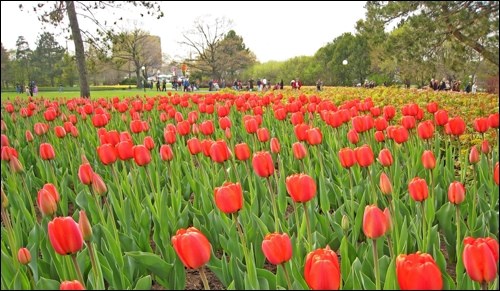Tulips add spring colour to a perennial or mixed border and are often used in annual beds. Native to the Near East, the genus name, Tulipa, is from the Turkish tulbend, meaning turban, a reference to the flower form.
They were cultivated and hybridized in Turkish gardens for centuries prior to their introduction to Holland and the garden of Carolus Clusius, a botany professor at the University of Leiden about1593. Stolen from his garden by botanical thieves, they quickly gained popularity among the wealthier Dutch.
By the 1630s, “tulipmania” was in full swing in Holland. Amid much speculation, enormous prices were paid for single bulbs, many with unusual striping or mottling. Unfortunately, these bulbs were not long-lived and many fortunes were lost. Both the unusual colouring and early demise of these bulbs were due to a virus.
Many tulips species and selections are not reliably hardy or long-lived on the prairies. Of the approximately 5,000 tulip cultivars and species available, the ones listed below are among your best bets for dependable spring colour. They combine drought tolerance, hardiness and a reliable perennial habit.
Darwin hybrids are those derived from crosses of single late tulips and what were once known as Darwin and Cottage tulips with Tulipa fosteriana and other botanical species. Darwin hybrids are tall plants with single flowers of good size and colour on sturdy stems. Most are 18 to 22 inches tall.
Apeldoorn – red with persimmon orange edges and interior.
Beauty of Apeldoorn – yellow washed with orange.
Golden Apeldoorn – golden yellow.
Golden Oxford – golden yellow, black interior base.
Oxford – scarlet flushed with red.
Parade – red, large black interior base edged with yellow.
Pink Impression (Spring Pearl) – large pink-rose flower.
From central Asia, the T. fosteriana hybrids have large flowers with wide petals and shiny foliage on stems 12–24 inches tall. All are early flowering. They are hybrids of T. fosteriana and T. greigii or T. kaufmanniana.
Orange Emperor – large, dark orange, early, 18 inches.
Pink Emperor – pink with pearl sheen, 14 inches.
Red Emperor (Madam Lefeber) – red with black centre, 16 inches.
White Emperor (Purissima) – white with yellow interior, 16 inches.
Yellow Emperor – yellow, 16 inches.
Tulipa greigii hybrids are short and multi-stemmed, with large, cup-shaped, early blooms. From central Asia, the species is red-orange with distinctive foliage characterized by purple-and-green striping or mottling.
Red Riding Hood – carmine red and scarlet, 14 inches.
Toronto – salmon-pink, 12 inches .
Tulipa praestans hybrids, from central Asia and Turkestan, are 8 to 12 inches tall with multiple flowers in mid-spring.
Fusilier – vermillion red-dark orange, glaucous grey-green foliage, 10–12 inches
Van Tubergen – large orange scarlet flowers, 10 inches.
Tulipa tarda, from central Asia, is only four to six inches tall, with yellow, white-tipped petals. It very quickly forms low colonies and is truly perennial. No garden should be without it! An excellent addition to your rock garden.
Tulipa urumiensis, native to Lake Urumia in Iran, is also a low colonizer, five inches tall with yellow petals. Also for use in rock gardens.
Tulip Planting Instructions
Tulips do best in full sun with good soil drainage. Purchase them as soon as they become available in the fall and plant them immediately. The rule of thumb for planting bulbs: dig a hole two to three times as deep as the bulb is tall. Add bonemeal (a source of phosphorous and nitrogen) to the bottom of the hole to encourage strong rooting. Water well, mulch with weed-free straw and hope for an early and continuous snow cover – their best insulation!
Sara is the author of numerous gardening books, among them the revised Creating the Prairie Xeriscape. And with Hugh Skinner: Gardening Naturally; Trees and Shrubs for the Prairies, and Groundcovers & Vines for the Prairies.
— This column is provided courtesy of the Saskatchewan Perennial Society (www.saskperennial.ca; hortscene@yahoo.com; www.facebook.com/saskperennial). Check out our Bulletin Board or Calendar for upcoming garden information sessions, workshops, tours and other events: Sept 30 & Oct 1, Canadian Prairie Lily Society’s annual bulb sale at The Mall at Lawson Heights (www.prairielily.ca).



